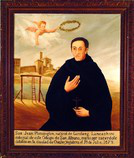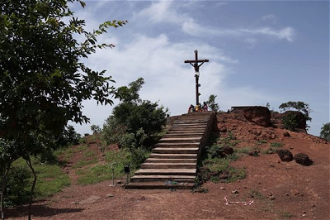Shrewsbury: Bishop appeals for funds to identify possible remains of St John Plessington

English College Valladolid image
The Bishop of Shrewsbury will this weekend appeal for donors to help to fund research that might conclusively establish whether parts of skeleton of a martyred priest belong to St John Plessington. A team of forensic scientists have examined the human remains and have concluded that they are the skull and the intact right leg of priest who was hanged, drawn and quartered, probably in the late 17th century. The injuries include a hole in the top of the skull inflicted from the inside when a pike was pushed through the head.
The bones were also found in a garment dating from the period of the fabricated Popish Plot of Titus Oates which resulted in St John dying as a martyr in Chester in 1679.
The circumstantial evidence pointing to the likelihood that the bones are those of St John is overwhelming but DNA from the bones needs to be matched to DNA from other relics of the saint to prove that they are his.
Bishop Davies is now inviting donors to come forward to help to pay for the work that would have to be undertaken by a research unit specialising in ancient DNA.
The full story of the discovery of the bones and the appeal by Bishop Mark Davies is told in the autumn 2015 edition of the Shrewsbury Catholic Voice, which will be on sale in churches across the diocese this weekend.
Bishop Davies told the magazine: "By his faithfulness to the point of death, St John Plessington stands out as the great witness to the priestly life and mission in Shrewsbury Diocese. As one of England's 40 martyrs he points to the long continuity of our Catholic faith and our unswerving loyalty to the See of Peter. If funds could be found to identify and authenticate his relics it would allow our connection to his heroic ministry and martyrdom to become visible and tangible in a new way for generations to come."
The bones were first discovered in the late 19th century hidden in a pub next to St Winefride's Well, Flintshire, which doubled as the headquarters of Jesuit missionaries working in the area during penal times.
They were taken to the nearby Jesuit retreat house of St Beuno's where they were venerated in the sacristy as the relics of an "anonymous martyr".
Recently they have been returned to Holywell where custodians invited the team of forensic specialists from Edinburgh University to examine them.
St John Plessington was executed after bloody Elizabethan statutes that made being a priest an offence of high treason were enforced during the hysteria incited by Oates.
He stands out from other martyrs of that period because he wrote down his final testament, which still exists, and in which he pleads his absolute innocence of the charges against him but also asserts with tremendous fortitude his willingness to die for his faith.
He was canonised in 1970 by Blessed Pope Paul VI as one of the 40 Martyrs of England and Wales.
During his homily at the Mass, Pope Paul quoted from the last testament and prayer of the saint.
An attempt in 1962 to recover the remains of St John from their supposed resting place in the graveyard of St Nicholas's Church in Burton, Wirral, resulted in failure.
Anyone who might be able to help to pay for further research should contact Pauline McCulloch at Pauline.mcculloch@dioceseofshrewsbury.org


















